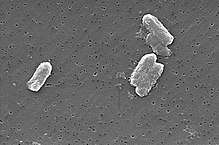Citrobacter
Citrobacter is a genus of Gram-negative coliform bacteria in the family Enterobacteriaceae.
| Citrobacter | |
|---|---|
 | |
| Citrobacter freundii | |
| Scientific classification | |
| Domain: | Bacteria |
| Phylum: | Proteobacteria |
| Class: | Gammaproteobacteria |
| Order: | Enterobacterales |
| Family: | Enterobacteriaceae |
| Genus: | Citrobacter Werkman and Gillen, 1932 |
| Species | |
The species C. amalonaticus, C. koseri, and C. freundii can use citrate as a sole carbon source. Citrobacter species are differentiated by their ability to convert tryptophan to indole (C. koseri is the only citrobacter to be commonly indole-positive), ferment lactose (C. koseri is a lactose fermentor), and use malonate.[2]
Citrobacter shows the ability to accumulate uranium by building phosphate complexes.[3]
Clinical significance
These bacteria can be found almost everywhere in soil, water, wastewater, etc. They can also be found in the human intestine. They are rarely the source of illnesses, except for infections of the urinary tract and infant meningitis and sepsis.[4][5]
C. freundii strains have inducible ampC genes encoding resistance to ampicillin and first-generation cephalosporins. In addition, isolates of Citrobacter may be resistant to many other antibiotics as a result of plasmid-encoded resistance genes.
References
- Parte, A.C. "Citrobacter". www.bacterio.net. Retrieved 18 October 2018.
- Benjamin A. Lipsky; Edward W. Hook III; Arlene A. Smith & James J. Plorde (1980). "Citrobacter Infections in Humans: Experience at the Seattle Veterans Administration Medical Center and a Review of the Literature". Clin Infect Dis. 2 (5): 746–760. doi:10.1093/clinids/2.5.746. ISSN 1058-4838.
- L. E. Macaskie; R. M. Empson; A. K. Cheetham; C. P. Grey; A. J. Skarnulis (1992). "Uranium bioaccumulation by a Citrobacter sp. as a result of enzymically mediated growth of polycrystalline HUO2PO4". Science. 257 (5071): 782–784. Bibcode:1992Sci...257..782M. doi:10.1126/science.1496397. PMID 1496397.
- V. Drelichman; J. D. Band (1985). "Bacteremias due to Citrobacter diversus and Citrobacter freundii. Incidence, risk factors, and clinical outcome". Archives of Internal Medicine. 145 (10): 1808–1810. doi:10.1001/archinte.145.10.1808. PMID 3899035.
- Badger, J.D.; M.F. Stins; K.S. Kim (1999). "Citrobacter freundii Invades and Replicates in Human Brain Microvascular Endothelial Cells". Infection and Immunity. 67 (8): 4208–15. PMC 96726. PMID 10417193.
External links
- Citrobacter at DSMZ - German Collection of Microorganisms and Cell Cultures
- Canada Public Health Data Sheet